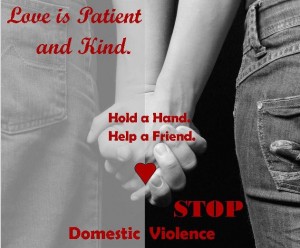 October is Domestic Violence Awareness Month, and the contentious Houses of Congress with their warring factions have added a darker level of meaning to domestic violence this year. The government shutdown and debt ceiling standoff, instigated by the Tea Party-ruled GOP, means that 80% of government-funded shelters will likely receive less support.
October is Domestic Violence Awareness Month, and the contentious Houses of Congress with their warring factions have added a darker level of meaning to domestic violence this year. The government shutdown and debt ceiling standoff, instigated by the Tea Party-ruled GOP, means that 80% of government-funded shelters will likely receive less support.
The only Washington DC organization that provides immediate services to victims and their families, DC SAFE, is struggling to keep its doors open. Even without such draconian budget cuts, most shelters aren’t adequately prepared to help victims who are gender variant, sexual minorities or male.
On the 25th Anniversary of “National Coming Out Day,” is coming out more risky for bisexuals? Statistics indicate: yes.
It’s also LGBT History Month with the 25th Anniversary of National Coming Out Day on October 11, 2013. This year’s theme, “Coming Out Still Matters,” encourages everyone to be as honest about their sexual orientation as possible. Among those who identify as lesbian, gay or bi, 50% are bisexual; yet, we’re probably the least visible. Is coming out more risky for bisexuals? Statistics indicate: yes.
At last month’s White House Roundtable on Bisexuality our team reported on bisexuals and domestic violence. Even we were shocked to find how disproportionately bisexual people are affected by intimate partner violence. Sadly, many with whom we’ve shared our findings react the way people often do to the existence of bisexuality itself: disbelieving that we or the statistics exist, minimizing and dismissing the discrimination against us, disputing that the abuse is so prevalent and “ordinary” and blaming bisexuals for their own victimization. Yes, we do need more bi awareness. October’s awareness initiatives offer opportunities to share the research, tell our stories and engage in thoughtful dialogue.
Sixty-one percent of bisexual women reported abuse, primarily by men…Thirty-seven percent of bi men reported sexually abusive intimate relationships, primarily with women.
The CDC’s 2010 National Intimate Partner and Sexual Violence Survey is one of the first studies to report victim statistics by all sexual orientation categories. Survey findings show that 61% of women who identify as bi report experiencing rape, physical violence and/or stalking by an intimate partner, and 90% of their perpetrators were male. In comparison, 44% of lesbians and 35% heterosexual women in the study had experienced domestic violence. Why is domestic violence so outrageously high for bisexual women in particular? And why do people have a hard time hearing this information at all, much less responding to it?
The stats for bisexual men are disturbing in a whole different way. Thirty-seven percent of bi men reported sexually abusive intimate relationships (compared to 26% of gay men and 29% of het men). Moreover, 78% of these bisexual men reported that they were abused by women. Clearly, more research needs to be done to understand what these findings mean.
But research isn’t being adequately funded, and services won’t improve in this political climate. Instead, projects are being stripped, gutted and de-funded. It’s discouraging that these severe cutbacks are occurring just as the beginning of good research on bi-specific issues is being addressed in social service agencies and organizations. Nevertheless, we included these recommendations in our report to federal officials:
- More research on bi-specific issues;
- Better training for law enforcement and social service agency employees; and
- Improve data collection and inter-agency uniformity of sexual orientation definitions and categories, such as a policy to count bisexuals separately from lesbians and gay men, and a consistent definition of “bisexual” for cross-study comparisons.
Beyond Only Recommending
We live in a very unstable time when basic human services are being cut, when many people are income-insecure, food-insecure, and often home-insecure. All of these conditions lead to increases in domestic violence while vital services are de-funded.
What good do powerful stories and passionate recommendations do in a time of such dire inequalities and injustices? What can we do besides raise our voices in protest and make suggestions? Appealing to people’s better nature and giving them vital information isn’t enough—either for policymakers or the average person.
We live in a very unstable time when basic human services are being cut, when many people are income-insecure, food-insecure, and often home-insecure. All of these conditions lead to increases in domestic violence while vital services are de-funded.
The last thing the brave women who started the movement against domestic violence wanted was to create a more punitive criminal justice system that punishes perps without helping them or changing the conditions that create violence in close relationships. The last thing they wanted, or that we today need, is an increasingly compromised system whose inadequate services merely pacify and distract, while domestic violence’s root causes remain unaddressed.
Focusing on “Domestic Violence Awareness” in October isn’t enough. But it’s a start. Making a “way out of no way” is definitely what it’s all about.


